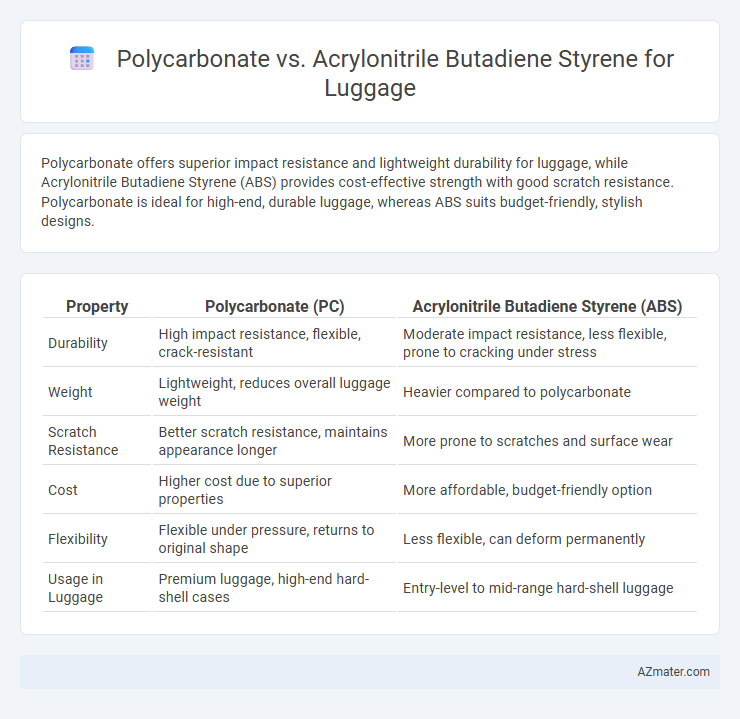Polycarbonate offers superior impact resistance and lightweight durability for luggage, while Acrylonitrile Butadiene Styrene (ABS) provides cost-effective strength with good scratch resistance. Polycarbonate is ideal for high-end, durable luggage, whereas ABS suits budget-friendly, stylish designs.
Table of Comparison
| Property | Polycarbonate (PC) | Acrylonitrile Butadiene Styrene (ABS) |
|---|---|---|
| Durability | High impact resistance, flexible, crack-resistant | Moderate impact resistance, less flexible, prone to cracking under stress |
| Weight | Lightweight, reduces overall luggage weight | Heavier compared to polycarbonate |
| Scratch Resistance | Better scratch resistance, maintains appearance longer | More prone to scratches and surface wear |
| Cost | Higher cost due to superior properties | More affordable, budget-friendly option |
| Flexibility | Flexible under pressure, returns to original shape | Less flexible, can deform permanently |
| Usage in Luggage | Premium luggage, high-end hard-shell cases | Entry-level to mid-range hard-shell luggage |
Introduction to Polycarbonate and ABS in Luggage
Polycarbonate (PC) and Acrylonitrile Butadiene Styrene (ABS) are two of the most common materials used in luggage manufacturing due to their durability and impact resistance. Polycarbonate is a lightweight, tough thermoplastic known for its high impact strength and flexibility, making it ideal for hard-shell luggage that can withstand rough handling. ABS offers good strength and rigidity at a lower cost but is generally heavier and less flexible than polycarbonate, often making it a favored choice for budget-friendly luggage options.
Material Composition and Properties
Polycarbonate (PC) luggage features a polymer matrix known for high impact resistance, transparency, and excellent thermal stability, making it lightweight yet durable under stress. Acrylonitrile butadiene styrene (ABS) luggage is composed of a terpolymer combining acrylonitrile, butadiene, and styrene, offering good toughness, moderate impact resistance, and cost efficiency with a slightly heavier build. PC offers superior scratch resistance and flexibility compared to ABS, which tends to be more rigid and prone to cracks under extreme impact or temperature fluctuations.
Durability and Impact Resistance Comparison
Polycarbonate offers superior impact resistance and exceptional durability, making it highly effective in absorbing shocks and resisting cracks during rough handling. Acrylonitrile butadiene styrene (ABS) is less impact-resistant and tends to crack or break under heavy stress, but it remains lightweight and cost-effective. For luggage durability, polycarbonate outperforms ABS by providing enhanced protection against dents, scratches, and breakage in demanding travel conditions.
Weight and Portability Factors
Polycarbonate luggage offers a lightweight design, improving portability without sacrificing durability, making it ideal for frequent travelers seeking ease of transport. Acrylonitrile butadiene styrene (ABS) tends to be heavier, which can reduce overall portability but provides enhanced impact resistance and rigidity. When prioritizing weight and ease of carrying, polycarbonate is the preferred material due to its superior strength-to-weight ratio.
Aesthetic Appeal and Design Flexibility
Polycarbonate offers a sleek, glossy finish that enhances the aesthetic appeal of luggage, favored for its ability to maintain vibrant colors and high-impact resistance. Acrylonitrile butadiene styrene (ABS) provides greater design flexibility with its matte surface, allowing for varied textures and patterns but typically at a lower scratch resistance compared to polycarbonate. The choice between polycarbonate and ABS hinges on whether priority is given to premium visual appeal or customizable design options in luggage manufacturing.
Cost Differences and Affordability
Polycarbonate luggage typically costs more than acrylonitrile butadiene styrene (ABS) options due to its higher durability and impact resistance, offering long-term value despite the initial investment. ABS luggage is generally more affordable, making it a popular choice for budget-conscious travelers seeking lightweight and cost-effective solutions. Price differences between polycarbonate and ABS can vary by brand and features, but ABS remains the economical option with reasonable durability for everyday use.
Security and Theft Protection
Polycarbonate offers superior impact resistance and shatterproof durability, enhancing the security and theft protection of luggage by preventing easy break-ins through cracks or dents. Acrylonitrile butadiene styrene (ABS), while affordable and lightweight, is more prone to cracking under force, potentially compromising the suitcase's structural integrity and making it easier for thieves to access contents. Polycarbonate's resilience against forced entry makes it the preferred choice for travelers prioritizing theft protection and long-lasting security.
Environmental Impact and Sustainability
Polycarbonate luggage offers greater durability and impact resistance, extending the product's lifespan and reducing the frequency of replacement, which positively impacts sustainability. Acrylonitrile butadiene styrene (ABS) is generally less durable, leading to higher consumption and waste, but it is often recyclable, aiding in circular economy efforts. The production of polycarbonate involves higher energy consumption and emissions compared to ABS, making ABS a more environmentally favorable choice in terms of carbon footprint.
Maintenance and Longevity
Polycarbonate luggage offers superior impact resistance and flexibility, reducing the likelihood of cracks and making it easier to maintain over time. Acrylonitrile butadiene styrene (ABS) is more prone to scratches and may require more frequent repairs or replacements to maintain appearance and structural integrity. Polycarbonate's durability and resistance to wear contribute to greater longevity, making it a preferred choice for travelers seeking long-lasting luggage.
Choosing the Best Material for Your Travel Needs
Polycarbonate offers exceptional impact resistance and lightweight durability, ideal for frequent travelers needing protection against rough handling. Acrylonitrile butadiene styrene (ABS) provides cost-effective strength and rigidity, making it suitable for occasional use or budget-conscious buyers. Evaluating the balance between polycarbonate's superior flexibility and ABS's affordability helps select the optimal luggage material based on travel frequency and durability requirements.

Infographic: Polycarbonate vs Acrylonitrile butadiene styrene for Luggage
 azmater.com
azmater.com